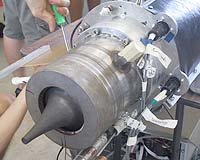 |
Menlo Park CA (SPX) Jun 19, 2009 Move over, silicon-it may be time to give the Valley a new name. Physicists at the Department of Energy's (DOE) SLAC National Accelerator Laboratory and Stanford University have confirmed the existence of a type of material that could one day provide dramatically faster, more efficient computer chips. Recently-predicted and much-sought, the material allows electrons on its surface to travel with no loss of energy at room temperatures and can be fabricated using existing semiconductor technologies. Such material could provide a leap in microchip speeds, and even become the bedrock of an entirely new kind of computing industry based on spintronics, the next evolution of electronics. Physicists Yulin Chen, Zhi-Xun Shen and their colleagues tested the behavior of electrons in the compound bismuth telluride. The results, published online June 11 in Science Express, show a clear signature of what is called a topological insulator, a material that enables the free flow of electrons across its surface with no loss of energy. The discovery was the result of teamwork between theoretical and experimental physicists at the Stanford Institute for Materials and Energy Science, a joint SLAC-Stanford institute. In recent months, SIMES theorist Shoucheng Zhang and colleagues predicted that several bismuth and antimony compounds would act as topological insulators at room-temperature. The new paper confirms that prediction in bismuth telluride. "The working style of SIMES is perfect," Chen said. "Theorists, experimentalists, and sample growers can collaborate in a broad sense." The experimenters examined bismuth telluride samples using X-rays from the Stanford Synchrotron Radiation Lightsource at SLAC and the Advanced Light Source at Lawrence Berkeley National Laboratory. When Chen and his colleagues investigated the electrons' behavior, they saw the clear signature of a topological insulator. Not only that, the group discovered that the reality of bismuth telluride was even better than theory. "The theorists were very close," Chen said, "but there was a quantitative difference." The experiments showed that bismuth telluride could tolerate even higher temperatures than theorists had predicted. "This means that the material is closer to application than we thought," Chen said. This magic is possible thanks to surprisingly well-behaved electrons. The quantum spin of each electron is aligned with the electron's motion-a phenomenon called the quantum spin Hall effect. This alignment is a key component in creating spintronics devices, new kinds of devices that go beyond standard electronics. "When you hit something, there's usually scattering, some possibility of bouncing back," explained theorist Xiaoliang Qi. "But the quantum spin Hall effect means that you can't reflect to exactly the reverse path." As a dramatic consequence, electrons flow without resistance. Put a voltage on a topological insulator, and this special spin current will flow without heating the material or dissipating. Topological insulators aren't conventional superconductors nor fodder for super-efficient power lines, as they can only carry small currents, but they could pave the way for a paradigm shift in microchip development. "This could lead to new applications of spintronics, or using the electron spin to carry information," Qi said. "Whether or not it can build better wires, I'm optimistic it can lead to new devices, transistors, and spintronics devices." Fortunately for real-world applications, bismuth telluride is fairly simple to grow and work with. Chen said, "It's a three-dimensional material, so it's easy to fabricate with the current mature semiconductor technology. It's also easy to dope-you can tune the properties relatively easily." "This is already a very exciting thing," he said, adding that the material "could let us make a device with new operating principles." Share This Article With Planet Earth
Related Links SLAC National Accelerator Laboratory Space Technology News - Applications and Research
 Using High-Pressure 'Alchemy' To Create Nonexpanding Metals
Using High-Pressure 'Alchemy' To Create Nonexpanding MetalsPasadena CA (SPX) Jun 19, 2009 By squeezing a typical metal alloy at pressures hundreds of thousands of times greater than normal atmospheric pressure, scientists at the California Institute of Technology (Caltech) have created a material that does not expand when heated, as does nearly every normal metal, and acts like a metal with an entirely different chemical composition. The discovery, described in a paper in ... read more |
|
| The content herein, unless otherwise known to be public domain, are Copyright 1995-2009 - SpaceDaily. AFP and UPI Wire Stories are copyright Agence France-Presse and United Press International. ESA Portal Reports are copyright European Space Agency. All NASA sourced material is public domain. Additional copyrights may apply in whole or part to other bona fide parties. Advertising does not imply endorsement,agreement or approval of any opinions, statements or information provided by SpaceDaily on any Web page published or hosted by SpaceDaily. Privacy Statement |